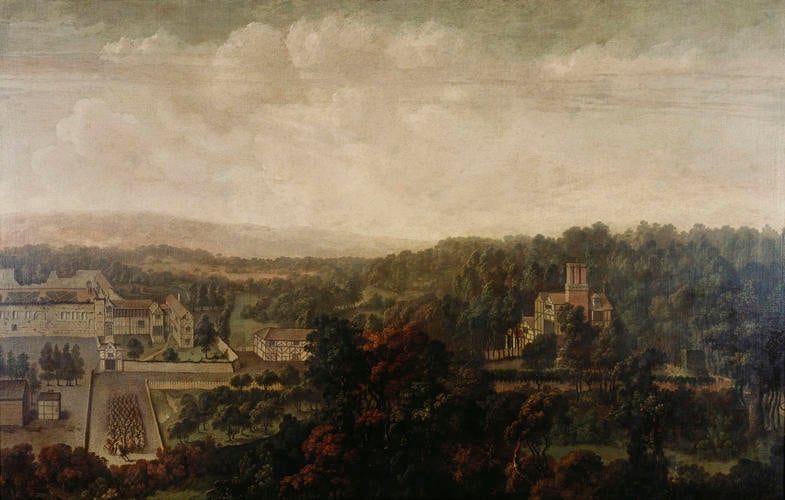-
1 of 253523 objects
Boscobel House and White Ladies c.1670
Oil on canvas | 136.7 x 211.5 cm (support, canvas/panel/stretcher external) | RCIN 404761

Robert Streeter (1624-80)
Boscobel House and White Ladies c.1670
-
Streeter was appointed Serjeant-painter to Charles II in 1663 and seems to have worked as a journeyman-artist executing copies, decorative panels for palace interiors, barges and coaches, stage scenery and some landscapes.
White Ladies Priory is now a barely-surviving ruin and Boscobel House a much-restored and extended seventeenth-century farmhouse; they are about a mile apart on the Shropshire-Staffordshire border near Bishop's Wood. Their fame derives from the fact that, after his defeat at the Battle of Worcester, Charles II holed up here from the 3rd to the 7th of September 1651. He arrived during the night of the 3rd at White Ladies (then a country house) with its owner, Charles Giffard. His followers (probably the squadron seen on the extreme left) galloped off; the King spent the next day as a woodman with Giffard's tenant, Richard Penderel. That night he attempted unsuccessfully to cross the Severn and make his escape through Wales; instead he returned in the early hours of the 6th to Boscobel, where he met up with Colonel William Careless. The two men spend the day hiding in Boscobel Wood within the branches of the famous Royal Oak tree (an arboreal descendant of which survives to this day within the obligatory railings). The King spent that night in the house and the next day in its garden before proceeding to Moseley Hall at dusk on the 7th. All this time Cromwell's troops were searching the area coming within hailing distance of the King.
Charles II enjoyed recalling his darkest hour and presumably commissioned this record, probably in c. 1670. White Ladies appears to the left; Boscobel to the right and the Royal Oak in the centre foreground. Numbers are just visible on this canvas suggesting that originally there was a key, as there is for Hollar's print of the same subject.
For the first hundred years of its existence (from 1660-1760) British landscape painting treats exclusively the subject of the country estate and the orderly disposition of nature over which it presides. This is in some ways another example of the same subject as a Priory and farm-house nestle in an idyllic forested landscape. Like the idea of the 'Royal Oak', which still adorns so many pub signs, this landscape seems to suggest that in such a scene a King is a natural ornament while a republican army is a monstrous aberration.Provenance
Presumably painted for Charles II; recorded in the Square Table Room at Whitehall in 1688 (no 75); in store at Windsor Castle in 1710 (no 20), it emerges in the Admiral's Gallery at Windsor in 1813 and 1816, at around which time it was moved to the Queen's State Bedchamber, where it appears in Pyne's illustrated Royal Residences of 1819 (RCIN 922103).
-
Creator(s)
-
Medium and techniques
Oil on canvas
Measurements
136.7 x 211.5 cm (support, canvas/panel/stretcher external)
150.5 x 225.7 x 9.0 cm (frame, external)
Category
Object type(s)